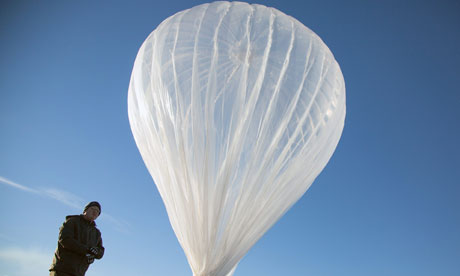Google has changed our lives first with its search engines and then with so many services it offers to us from mail, blogs, docs, scholar, etc. All these enable fast paced research, knowledge sharing, collaboration, and above all connection among people! Now, Google is expanding its horizons even further by realizing that not all people in the world have access to broadband internet to be able to benefit from these services to begin with. So, they want to solve that problem too. I have recently learned about a couple of their efforts for providing free broadband internet to remote rural areas. The first one is Google's balloon project, Loon, aiming at providing internet access to underprivileged and disconnected (to internet that is) areas of the world. In this project Google launches balloons to a 20 km altitude. These balloons are powered with solar energy and their navigation algorithms consider and benefit from wind direction! They are much cheaper than launching satellites and can provide internet coverage for up to a 25 mile radius [2]! The balloons travel around the world. For example, the same balloon that was over South Africa will be over South America eventually [3].

While the idea is smart and cost-effective, Google, like most big organizations and even countries, is beginning to learn that its hardest challenges are
not technological [3-4]. The problem is beyond local, state, or governmental bureaucracy, it is
international bureaucracy! [4] Loon project needs to cross borders of many countries with different politics and rules. For example, Texas and Tehran happen to be in the same altitude [3]. Will a Google balloon make its way to Iran's aerospace or China's? I am curious to see how Google manages to connect the world on internet! It seems like Google was well-aware and willing to take on these challenges and they chose this name, Loon, partly to recognize the strange and seemingly unrealistic goals they want to achieve! [5] Regardless, any new country and region they give broadband internet access to, be it in Africa or Asia, connecting children and adults to educational and informative resources, is a great service to humanity.
On June 16, 2013 Google started a trial of this project with 30 balloons over New Zealand! After this pilot run, Google plans on sending 300 balloons to cover areas in Argentina, Australia, New Zealand, and Chile, and later on Google dreams of having thousands of such balloons in
stratosphere[5]
I talk about another Google effort for providing internet access to people all over the world in a second post.
To learn more about the Loon project please check out the references below.
References:
[1]
http://www.google.com/loon/
[2]
http://www.telegraph.co.uk/sponsored/technology/technology-trends/10162043/google-project-loon.html
[3]
http://gigaom.com/2013/06/21/project-loon-googles-biggest-obstacle-isnt-technology-its-politics/
[4]
http://www.forbes.com/sites/timworstall/2013/06/23/googles-project-loon-problem-international-bureaucracy/
[5]
http://en.wikipedia.org/wiki/Project_Loon
[6]
http://www.guardian.co.uk/technology/2013/jun/15/project-loon-google-balloon-internet


